Are you curious about those many-legged creatures you’ve spotted in your garden? Millipedes may look intimidating with their numerous legs and coiling behavior, but they play an important role in our ecosystem. This guide explores the different types of millipedes and their fascinating characteristics.
Millipedes are harmless arthropods with elongated bodies and multiple legs. Despite their name suggesting “thousand legs,” most species have between 40-400 legs. These decomposers help break down organic matter in soil, making them beneficial garden residents despite their sometimes unsettling appearance.
Millipede Identification
Millipedes are arthropods belonging to the group Myriapoda. These creatures have several distinctive characteristics that help differentiate them from similar-looking arthropods:
- A tough exterior exoskeleton with many body segments
- Two pairs of legs on most body segments (unlike centipedes, which have one pair per segment)
- Most have glands that produce defensive secretions
- Typically dark brown or black in color, though some toxic species display bright warning colors
- Move with a slow, wave-like motion

Are Millipedes Insects?
Though often mistaken for insects, millipedes belong to a different arthropod classification. The main differences are:
- Insects have three main body segments; millipedes have numerous segments
- Insects have three pairs of legs; millipedes have many more
- Millipedes have a cylindrical body shape compared to most insects
Millipede Habitat
Millipedes thrive in specific environments that provide moisture and decaying organic matter. Their preferred habitats include:
- Under rocks and stones
- Beneath beds of wet leaves
- Near plant roots and in rich soil
- In piles of grass clippings or mulch
- Under logs and in decaying wood

Millipedes generally don’t venture far from their preferred habitats since they find both shelter and food in the same areas. They prefer moist environments with ample decaying plant material.
Types of Millipedes by Species
The world hosts thousands of millipede species, but several common types are frequently encountered in gardens and wooded areas across North America and Europe.
-
Cylindroiulus Caeruleocinctus
This large kidney-shaped millipede (20-30mm) displays a blend of brown-black coloring with brass-like segment edges. Commonly found in residential areas with leafy vegetation, including forests, bushy areas, and parks.
Cylindroiulus Caeruleocinctus -
White-legged Snake Millipede (Tachypodoiulus niger)
Growing up to 25mm, this species is immediately recognizable by its tubular black body and contrasting white legs (about 100 of them). It features a pointed rear projection extending from the telson. Most commonly found in woodlands, gardens, and areas with rotting foliage or leaf litter.
Tachypodoiulus niger -
Striped Millipede (Ommatoiulus sabulosus)
One of the larger millipede species, easily identified by the distinctive ginger stripes running along its segmented body. Typically found in sandy areas during daylight hours and hides under logs, in trees, or on internal walls.
Ommatoiulus sabulosus
Large Millipede Species
The giant millipedes belong to the Spirostreptida order. Most of these impressive arthropods inhabit tropical and arid coastal regions, particularly in East Africa. Some can reach remarkable sizes and can live up to five years.
Giant African Millipede
Scientifically known as Archispirostreptus Gigas, the Giant African millipede is one of the largest millipede species in the world.
- Grows up to 15.2 inches (38.5 cm) in length
- Reaches approximately 2.6 inches (67 mm) in circumference
- Features around 256 legs on average
- Black coloration and can live up to 7 years
- Native to East Africa, Mozambique, and wetlands of South Africa
These giants have a fascinating symbiotic relationship with small mites, which get free meals and protection while providing grooming services by cleaning the millipede’s exoskeleton and between its many legs.
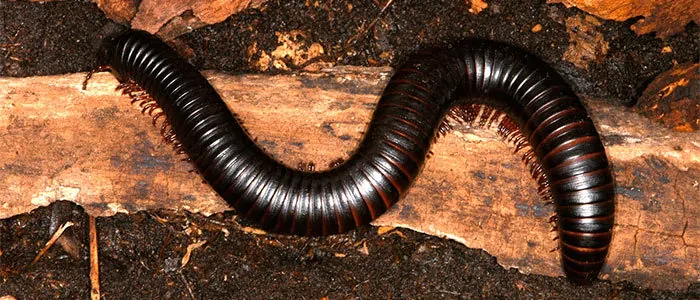
American Giant Millipede
The American giant millipede (Narceus americanus) is North America’s largest native millipede species.
- Grows up to 10 cm in length
- Features a cylindrical shape unlike flatter millipede species
- Displays dark red-brown or black coloration with distinctive red lines on segment sides
- Has two pairs of legs on most segments, with first four segments having only one pair each
- Primarily lives in forested areas in decaying logs and leaf litter
American giant millipedes, like most millipede species, feed on decaying plant matter. They play an important ecological role by breaking down dead vegetation and returning nutrients to the soil. When threatened, they curl into a tight defensive ball or secrete defensive chemicals.
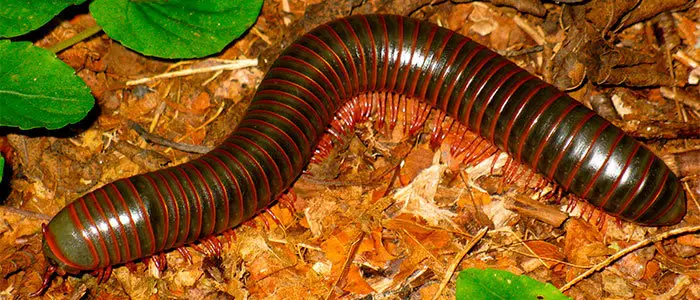
Flat-Backed Millipedes (Order Polydesmida)
The Polydesmida order forms the largest group of millipedes with nearly 3,500 species. They’re called “flat-backed” due to the distinctive keels on each body segment.
- Size ranges from tiny 3mm species to large 130mm specimens
- Characterized by the absence of eyes
- Possess small pairs of legs projecting from the lower body
- Many larger species display bright warning colors to signal their toxic secretions
- Primarily inhabit and feed on rotting vegetation

Millipede Color Variations
Millipedes come in a diverse range of colors depending on their species and habitat. Color often serves a functional purpose:
-
Brown/Black Millipedes
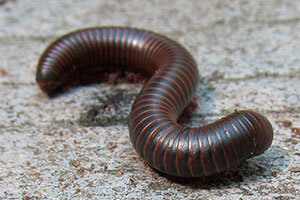
Most common in North America, these docile species typically live secluded lives in decaying vegetation and are frequently found in residential yards. -
White/Red Millipedes
These brightly colored species use aposematic (warning) coloration as a defensive mechanism, alerting potential predators to their toxic secretions.


Millipedes in Gardens and Homes
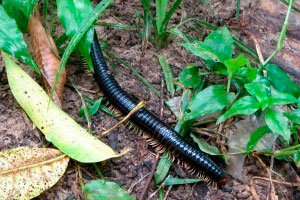
Millipedes are primarily nocturnal, emerging at night to feed and hiding in damp, dark places during the day. Despite their sometimes intimidating appearance, they’re harmless decomposers that can actually benefit your garden by recycling nutrients.
If you find millipedes have moved into unwanted areas of your home or garden, there are several non-chemical methods to discourage them:
- Regularly sweep decomposing leaves and plant debris
- Remove soil borders from exterior walls and trim vegetation around the perimeter
- Declutter your yard by removing old boxes, logs, and other potential hiding places
- Reduce thatch in your garden by clearing dead leaves, especially in early fall
- Gently relocate millipedes found indoors using a broom—they’ll naturally coil into a defensive ball, making them easy to move
- Seal cracks behind baseboards and in foundations where moisture might attract millipedes
- Use dehumidifiers to dry out damp areas in basements or crawl spaces
Ecological Importance of Millipedes
Millipedes play a vital role in soil ecology and garden health:
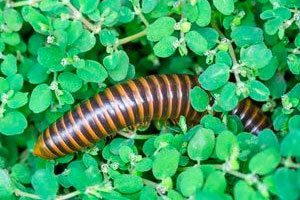
- They’re primary decomposers in the soil food chain, breaking down dead plant matter
- Millipedes account for approximately 10% of leaf litter decomposition in many environments
- They enhance the creation of microorganisms that convert debris into nutrient-rich soil
- In environments lacking earthworms, millipedes fill this crucial ecological niche
- They improve soil chemistry and nutrient cycling in various ecosystems

Millipede Diet
Unlike centipedes, which are carnivorous hunters, millipedes have a strictly vegetarian diet that primarily consists of:

- Decaying leaves and plant debris
- Rotting wood
- Dead plant material
- Algae and fungi
Far from being garden pests, millipedes actually help improve soil quality by breaking down organic matter and contributing to the nutrient cycle, helping your plants thrive year-round.
Are Millipedes Dangerous?
Millipedes are generally harmless to humans and pets, but they do have defensive mechanisms:
- No millipede species are venomous or poisonous to humans
- They cannot bite or sting
- When threatened, millipedes curl into a protective spiral
- As a last resort, they can release defensive secretions that may cause mild skin irritation
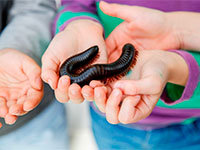
Millipede defensive secretions can contain various compounds including hydrogen cyanide, organic acids, phenols, and benzoquinones. While not dangerous in small amounts, it’s best to avoid direct handling and always wash hands after contact.
Potential Reactions to Millipede Secretions
While rare, some individuals may experience mild reactions if they come into contact with millipede defensive fluids:
- Skin irritation – The acidic components in the secretions may cause temporary irritation
- Redness – A common sign of mild contact reaction
- Temporary discoloration – Some secretions can cause temporary skin discoloration
- Eye irritation – In rare cases where secretions contact the eyes, temporary irritation may occur

If you come into contact with millipede defensive secretions, follow these steps:
- Wash thoroughly with plenty of water and mild soap
- If available, apply papain (found in papaya) to help neutralize irritants
- For skin reactions, a mild corticosteroid cream can reduce inflammation
- Cover irritated areas with a clean bandage if needed
Millipedes and Pets
Millipedes generally pose little risk to pets, but some precautions are worth noting:

- Most pets will leave millipedes alone after initial curiosity
- If a pet disturbs a millipede, it may release defensive secretions
- These secretions can cause temporary discomfort if they contact sensitive areas
- If a pet ingests a millipede, mild digestive upset might occur but is rarely serious
If your pet shows prolonged symptoms after encountering a millipede, such as excessive vomiting, lack of appetite, or lethargy, consult your veterinarian.
Frequently Asked Questions
Are Millipedes Venomous?
Millipedes do not produce venomous substances. They are harmless creatures that pose no death threat to humans or pets. Their primary defense mechanism is to curl into a protective ball when threatened.
While they can produce irritating secretions as a secondary defense, these are not venomous and generally cause only mild, temporary irritation if they contact skin.
Do Millipedes Bite?
Millipedes do not bite, even when threatened. They are slow-moving detritivores that feed primarily on decomposing plant matter and lack the mouthparts necessary to bite humans or animals.
Their defensive strategies are limited to curling into a protective ball and, if severely provoked, secreting defensive chemicals.
Are Millipedes Dangerous?
Millipedes are not dangerous creatures. They don’t bite, sting, or transmit diseases. Their defensive secretions can cause mild skin irritation but are not harmful unless they contact sensitive areas like the eyes.
When handling millipedes, it’s advisable to wear gloves and wash hands thoroughly afterward to avoid any potential irritation from their secretions.
What Eats Millipedes?
Millipedes have several natural predators including shrews, badgers, birds, raccoons, possums, and toads. Younger millipedes may also fall prey to large ants, ground beetles, and spiders.
Their defensive secretions and ability to curl into a protective ball help protect them from many predators, but they remain an important food source in various ecosystems.
Are Millipedes Harmful to Cats?
Millipedes generally pose minimal risk to cats. If a cat disturbs a millipede, the arthropod may release irritating secretions that can cause temporary discomfort if they contact sensitive areas.
If a cat ingests a millipede, mild digestive upset might occur but is rarely serious. Wash affected areas with water if your pet shows signs of irritation after encountering a millipede.
Do Millipedes Sting?
Millipedes do not have stingers and cannot sting. Their only defensive mechanisms are curling into a protective ball and secreting defensive chemicals if severely threatened.
Are Millipedes Harmful to Gardens?
Far from being harmful, millipedes are actually beneficial to gardens. They contribute to soil health by breaking down dead plant material and returning nutrients to the soil.
Unlike many garden pests, millipedes don’t eat living plants but instead focus on decaying organic matter. Their presence often indicates healthy soil with good organic content.
What Attracts Millipedes?
Millipedes are attracted to environments that provide their basic needs: moisture, shelter, and decaying organic matter to feed on. Common attractants include mulch, leaf piles, rotting wood, and consistently damp areas.
They’re especially drawn to recently watered garden beds with rich soil and areas with accumulations of decomposing plant material.
How Many Legs Does a Millipede Have?
Despite their name meaning “thousand legs,” millipedes typically have anywhere from 40 to 400 legs depending on the species and individual. They have two pairs of legs on most body segments, with new segments and legs being added as they grow.
The number of legs a millipede has can change throughout its lifetime as it develops and molts.

Every spring we have an abundance of tiny millipedes that seem to come out of the mortar between the bricks on our concrete porch. They are about 1/4 inch in length, fall to the porch floor and die soon after. I have sprayed insect repellant, and sprayed lacquer on the mortar in an attempt to fill any holes they may live in. In all my research, I can find no information about living in that environment, yet they seem to thrive until they fall on the porch floor.
The cracks in mortar between bricks can create the perfect micro-habitat for them, especially in the spring. Even though it’s not commonly listed as their main hiding spot, if there’s enough dampness and organic matter trapped in there (even dust, mold, or algae), they’ll happily hang out until conditions change.
They’re probably breeding or sheltering inside those small gaps, then either getting pushed out by overcrowding or crawling out as temperatures shift. Once they hit the dry, exposed porch surface, they dehydrate quickly and die—especially since they need a lot of moisture to survive.
Lacquer might help seal the surface, but it won’t get deep into the mortar or address the moisture inside. Here’s what might actually help:
They’re harmless, just kind of gross in numbers, but it sounds like you’re doing all the right things—just might need a deeper seal and moisture check to fully stop them.
In our community dog park, the mud puddles are crawling with white centipedes. I don’t see them on the list of centipedes here.
Hi Chris,
You’ve probably found your answer, but one option is that the millipedes are young. We find young ones that we sell on eBay, and although the millipedes mature into grey pets, they are a very light grey (almost white) as youth.
Hi, can you please help me out with my millipede situation?
I need to know what a Cylindroiulus caeruleocinctus millipede eats
and how you take care of it.
Thank you
Hi Oliver,
Hopefully you’ve found food for your millipede.
Here, where we forage for millipedes pets, they munch oak for lunch. As long as the sticks (2”-4” diameter) are a bit decomposed (soft and damp), the little guys have food.
However, the best food is the forest mat—so much so, that we sell a bag with each pet. I won’t put my eBay info here in case it’s not allowed, but you can probably find some for sale somewhere.